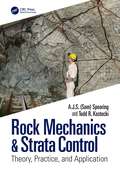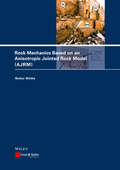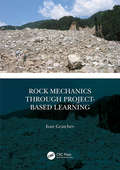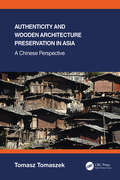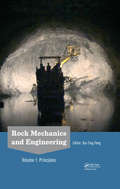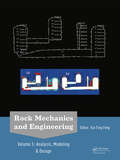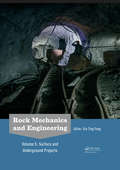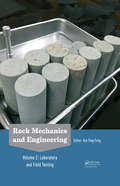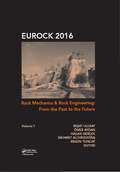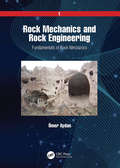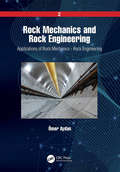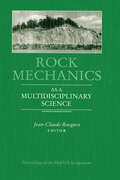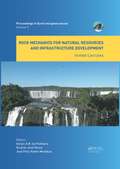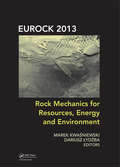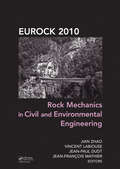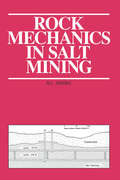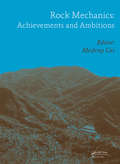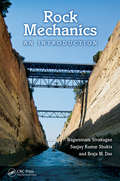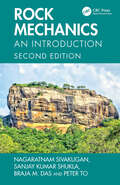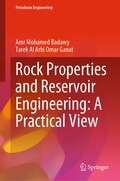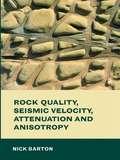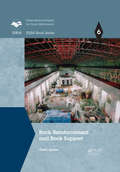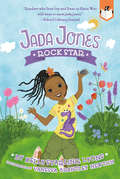- Table View
- List View
Rock Mechanics & Strata Control: Theory, Practice, and Application
by A.J.S. (Sam) Spearing T.R. (Todd KosteckiRock Mechanics and Strata Control: Theory, Practice, and Application serves as a handbook that examines many of the fundamental and practical aspects of rock mechanics and strata control needed to help ensure safe and effective surface and underground mining. Clearly written and comprehensive in scope, this book includes numerous worked examples to elaborate on how to interpret and use the rock mechanics and support principles presented. It also includes fundamental coverage of major aspects of the topic that students and practitioners would find useful. This book is aimed primarily as a teaching and reference book for students in mining engineering and other associated disciplines, such as civil engineering, geotechnical and geological engineering, and geology. It will also be useful for practitioners working in the industry as a reference, showing numerous practical application examples.This book: Focuses on rock mechanics and strata control from a green and sustainable point of view. Includes numerous examples and case studies showing how to apply concepts and formula.
Rock Mechanics Based on an Anisotropic Jointed Rock Model (AJRM)
by Walter WittkeThis book focuses on the fundamentals of rock mechanics as a basis for the safe and economical design and construction of tunnels, dam foundations and slopes in jointed and anisotropic rock. It is divided into four main parts: - Fundamentals and models - Analysis and design methods - Exploration, testing and monitoring - Applications and case histories. The rock mechanical models presented account for the influence of discontinuities on the stress-strain behavior and the permeability of jointed rock masses. This book is for: - Civil- and Mining-Engineers - Geologists - Students in the related fields
Rock Mechanics Contributions and Challenges: Proceedings of the 31st US Symposium on Rock Mechanics
by W. A. HustrulidThe theme of the 31st US Symposium on Rock Mechanics is 'Rock Mechanics contributions and challenges', having as objective the examination and quantification of the progress that has been achieved in addressing the major practical challenges facing the science of rock mechanics and mine design.The 124 papers included in the proceedings cover areas such as: experimental studies (laboratory and field); conceptual, analytical, and numerical modeling; design and construction methods. 35 papers deal with practical mining problems and include information on rock reinforcement technology, blasting, rock bursts, open pit mining, remote sensing and borehole geophysics, mechanical fragmentation, and subsidence. Areas emphasized are coal and metal mine design problems. Other papers deal with the newest computer models, new instruments, fracture mechanics, new laboratory testing techniques, and in situ testing.
Rock Mechanics Through Project-Based Learning
by Ivan GratchevTraditional textbooks on rock mechanics often fail to engage students in the learning process as such books are packed with theory that students are unlikely to use in their future employment. In contrast, this book delivers the fundamentals of rock mechanics using a more practical and engaging project-based approach which simulates what practitioners do in their real-life practice. This book will be of great help to those who would like to learn practical aspects of rock mechanics and better understand how to apply theory to solve real engineering problems. This book covers geology, rock mechanics principles, and practical applications such as rock falls, slope stability analysis and engineering problems in tunnels. Throughout the whole book, the reader is engaged in project-based work so that the reader can experience what rock mechanics is like and clearly see why it is an important part of geotechnical engineering. The project utilizes real field and laboratory data while the relevant theory needed to execute the project is linked to each project task. In addition, each section of the book contains several exercises and quiz questions to scaffold learning. Some problems include open-ended questions to encourage the reader to exercise their judgement and develop practical skills. To foster the learning process, solutions to all questions are provided to allow for learning feedback.
Rock Mechanics and Engineering Geology in Volcanic Fields: 5th International Workshop on Rock Mechanics and Engineering Geology in Volcanic Fields (RMEGV V, Fukuoka, Japan, 9–11 September 2021)
by Takehiro OhtaRock Mechanics and Engineering Geology in Volcanic Fields includes keynote lectures and papers from the 5th International Workshop on Rock Mechanics and Engineering Geology in Volcanic Fields (RMEGV2021, Fukuoka, Japan, 9-10 September 2021). This book deals with challenging studies related to solving engineering issues around volcanic fields, including: Volcanic geology, disasters and their mitigation Resources and energy in volcanic fields Mechanical behavior of volcanic rocks and soils Groundwater and environmental problems in volcanic fields Geotechnical engineering in volcanic fields Rock Mechanics and Engineering Geology in Volcanic Fields is of great interest to civil engineers and engineering geologists working in the areas of rock and soil mechanics, geotechnical engineering, geothermal energy, engineering geology, and environmental science.
Rock Mechanics and Engineering Volume 1: Principles
by Xia-Ting FengPrinciples is the first volume of the five-volume set Rock Mechanics and Engineering and contains twenty-four chapters from key experts in the following fields:- Discontinuities;- Anisotropy;- Rock Stress;- Geophysics;- Strength Criteria;- Modeling Rock Deformation and Failure. The five-volume set “Comprehensive Rock Engineering”, which was published in 1993, has had an important influence on the development of rock mechanics and rock engineering. Significant and extensive advances and achievements in these fields over the last 20 years now justify the publishing of a comparable, new compilation. Rock Mechanics and Engineering represents a highly prestigious, multi-volume work edited by Professor Xia-Ting Feng, with the editorial advice of Professor John A. Hudson. This new compilation offers an extremely wideranging and comprehensive overview of the state-of-the-art in rock mechanics and rock engineering and is composed of peer-reviewed, dedicated contributions by all the key experts worldwide. Key features of this set are that it provides a systematic, global summary of new developments in rock mechanics and rock engineering practices as well as looking ahead to future developments in the fields. Contributors are worldrenowned experts in the fields of rock mechanics and rock engineering, though younger, talented researchers have also been included. The individual volumes cover an extremely wide array of topics grouped under five overarching themes: Principles (Vol. 1), Laboratory and Field Testing (Vol. 2), Analysis, Modelling and Design (Vol. 3), Excavation, Support and Monitoring (Vol. 4) and Surface and Underground Projects (Vol. 5). This multi-volume work sets a new standard for rock mechanics and engineering compendia and will be the go-to resource for all engineering professionals and academics involved in rock mechanics and engineering for years to come.
Rock Mechanics and Engineering Volume 3: Analysis, Modeling & Design
by Xia-Ting FengAnalysis, Modeling & Design is the third volume of the five-volume set Rock Mechanics and Engineering and contains twenty-eight chapters from key experts in the following fields:- Numerical Modeling Methods;- Back Analysis;- Risk Analysis;- Design and Stability Analysis: Overviews;- Design and Stability Analysis: Coupling Process Analysis;- Design and Stability Analysis: Blast Analysis and Design;- Rock Slope Stability Analysis and Design;- Analysis and Design of Tunnels, Caverns and Stopes. The five-volume set “Comprehensive Rock Engineering”, which was published in 1993, has had an important influence on the development of rock mechanics and rock engineering. Significant and extensive advances and achievements in these fields over the last 20 years now justify the publishing of a comparable, new compilation. Rock Mechanics and Engineering represents a highly prestigious, multi-volume work edited by Professor Xia-Ting Feng, with the editorial advice of Professor John A. Hudson. This new compilation offers an extremely wideranging and comprehensive overview of the state-of-the-art in rock mechanics and rock engineering and is composed of peer-reviewed, dedicated contributions by all the key experts worldwide. Key features of this set are that it provides a systematic, global summary of new developments in rock mechanics and rock engineering practices as well as looking ahead to future developments in the fields. Contributors are worldrenowned experts in the fields of rock mechanics and rock engineering, though younger, talented researchers have also been included. The individual volumes cover an extremely wide array of topics grouped under five overarching themes: Principles (Vol. 1), Laboratory and Field Testing (Vol. 2), Analysis, Modelling and Design (Vol. 3), Excavation, Support and Monitoring (Vol. 4) and Surface and Underground Projects (Vol. 5). This multi-volume work sets a new standard for rock mechanics and engineering compendia and will be the go-to resource for all engineering professionals and academics involved in rock mechanics and engineering for years to come.
Rock Mechanics and Engineering Volume 4: Excavation, Support and Monitoring
by Xia-Ting FengExcavation, Support and Monitoring is the fourth volume of the five-volume set Rock Mechanics and Engineering and contains twenty-three chapters from key experts in the following fields- Excavation Methods;- Support Technology;- Monitoring Technology;- Integrated Engineering Monitoring and Analysis. The five-volume set “Comprehensive Rock Engineering”, which was published in 1993, has had an important influence on the development of rock mechanics and rock engineering. Significant and extensive advances and achievements in these fields over the last 20 years now justify the publishing of a comparable, new compilation. Rock Mechanics and Engineering represents a highly prestigious, multi-volume work edited by Professor Xia-Ting Feng, with the editorial advice of Professor John A. Hudson. This new compilation offers an extremely wide-ranging and comprehensive overview of the state-of-the-art in rock mechanics and rock engineering and is composed of peer-reviewed, dedicated contributions by all the key experts worldwide. Key features of this set are that it provides a systematic, global summary of new developments in rock mechanics and rock engineering practices as well as looking ahead to future developments in the fields. Contributors are world-renowned experts in the fields of rock mechanics and rock engineering, though younger, talented researchers have also been included. The individual volumes cover an extremely wide array of topics grouped under five overarching themes: Principles (Vol. 1), Laboratory and Field Testing (Vol. 2), Analysis, Modelling and Design (Vol. 3), Excavation, Support and Monitoring (Vol. 4) and Surface and Underground Projects (Vol. 5). This multi-volume work sets a new standard for rock mechanics and engineering compendia and will be the go-to resource for all engineering professionals and academics involved in rock mechanics and engineering for years to come.
Rock Mechanics and Engineering Volume 5: Surface and Underground Projects
by Xia-Ting FengSurface and Underground Projects is the last volume of the five-volume set Rock Mechanics and Engineering and contains twenty-one chapters from key experts in the following fields: - Slopes;- Tunnels and Caverns;- Mining;- Petroleum Engineering;- Thermo-/Hydro-Mechanics in Gas Storage, Loading and Radioactive Waste Disposal. The five-volume set “Comprehensive Rock Engineering”, which was published in 1993, has had an important influence on the development of rock mechanics and rock engineering. Significant and extensive advances and achievements in these fields over the last 20 years now justify the publishing of a comparable, new compilation. Rock Mechanics and Engineering represents a highly prestigious, multi-volume work edited by Professor Xia-Ting Feng, with the editorial advice of Professor John A. Hudson. This new compilation offers an extremely wideranging and comprehensive overview of the state-of-the-art in rock mechanics and rock engineering and is composed of peer-reviewed, dedicated contributions by all the key experts worldwide. Key features of this set are that it provides a systematic, global summary of new developments in rock mechanics and rock engineering practices as well as looking ahead to future developments in the fields. Contributors are worldrenowned experts in the fields of rock mechanics and rock engineering, though younger, talented researchers have also been included. The individual volumes cover an extremely wide array of topics grouped under five overarching themes: Principles (Vol. 1), Laboratory and Field Testing (Vol. 2), Analysis, Modelling and Design (Vol. 3), Excavation, Support and Monitoring (Vol. 4) and Surface and Underground Projects (Vol. 5). This multi-volume work sets a new standard for rock mechanics and engineering compendia and will be the go-to resource for all engineering professionals and academics involved in rock mechanics and engineering for years to come.
Rock Mechanics and Engineering: Laboratory and Field Testing
by Xia-Ting FengLaboratory and Field Testing is the second volume of the five-volume set Rock Mechanics and Engineering and contains nineteen chapters from key experts in the following fields:- Triaxial or True-triaxial Tests under Condition of Loading and Unloading;- Joint Tests;- Dynamic and Creep Tests;- Physical Modeling Tests;- Field Testing and URLs. The five-volume set “Comprehensive Rock Engineering”, which was published in 1993, has had an important influence on the development of rock mechanics and rock engineering. Significant and extensive advances and achievements in these fields over the last 20 years now justify the publishing of a comparable, new compilation. Rock Mechanics and Engineering represents a highly prestigious, multi-volume work edited by Professor Xia-Ting Feng, with the editorial advice of Professor John A. Hudson. This new compilation offers an extremely wideranging and comprehensive overview of the state-of-the-art in rock mechanics and rock engineering and is composed of peer-reviewed, dedicated contributions by all the key experts worldwide. Key features of this set are that it provides a systematic, global summary of new developments in rock mechanics and rock engineering practices as well as looking ahead to future developments in the fields. Contributors are worldrenowned experts in the fields of rock mechanics and rock engineering, though younger, talented researchers have also been included. The individual volumes cover an extremely wide array of topics grouped under five overarching themes: Principles (Vol. 1), Laboratory and Field Testing (Vol. 2), Analysis, Modelling and Design (Vol. 3), Excavation, Support and Monitoring (Vol. 4) and Surface and Underground Projects (Vol. 5). This multi-volume work sets a new standard for rock mechanics and engineering compendia and will be the go-to resource for all engineering professionals and academics involved in rock mechanics and engineering for years to come.
Rock Mechanics and Rock Engineering: From the Past to the Future
by Reşat Ulusay, Ömer Aydan, Hasan Gerçek, Mehmet Ali Hindistan and Ergün TuncayRock Mechanics and Rock Engineering: From the Past to the Future contains the contributions presented at EUROCK2016, the 2016 International Symposium of the International Society for Rock Mechanics (ISRM 2016, Ürgüp, Cappadocia Region, Turkey, 29-31 August 2016). The contributions cover almost all aspects of rock mechanics and rock engineering from theories to engineering practices, emphasizing the future direction of rock engineering technologies. The 204 accepted papers and eight keynote papers, are grouped into several main sections:- Fundamental rock mechanics- Rock properties and experimental rock mechanics- Analytical and numerical methods in rock engineering- Stability of slopes in civil and mining engineering- Design methodologies and analysis- Rock dynamics, rock mechanics and rock engineering at historical sites and monuments- Underground excavations in civil and mining engineering- Coupled processes in rock mass for underground storage and waste disposal- Rock mass characterization- Petroleum geomechanics- Carbon dioxide sequestration- Instrumentation-monitoring in rock engineering and back analysis- Risk management, and- the 2016 Rocha Medal Lecture and the 2016 Franklin Lecture Rock Mechanics and Rock Engineering: From the Past to the Future will be of interest to researchers and professionals involved in the various branches of rock mechanics and rock engineering. EUROCK 2016, organized by the Turkish National Society for Rock Mechanics, is a continuation of the successful series of ISRM symposia in Europe, which began in 1992 in Chester, UK.
Rock Mechanics and Rock Engineering: Volume 1: Fundamentals of Rock Mechanics
by Ömer AydanThe two-volume set Rock Mechanics and Rock Engineering is concerned with the application of the principles of mechanics to physical, chemical and electro-magnetic processes in the upper-most layers of the earth and the design and construction of the rock structures associated with civil engineering and exploitation or extraction of natural resources in mining and petroleum engineering. Volume 1, Fundamentals of Rock Mechanics, discusses rock-constituting elements, discontinuities and their behavior under various physical and chemical actions in nature. The governing equations together with constitutive laws and experimental techniques and the solution techniques are explained and some examples of applications are given. A number of chapters are devoted to possible new directions in rock mechanics. Rock Mechanics and Rock Engineering is intended to be a fundamental resource for younger generations and newcomers and a reference book for experts specialized in Rock Mechanics and Rock Engineering and associated with the fields of mining, civil and petroleum engineering, engineering geology, and/or specialized in Geophysics and concerned with earthquake science and engineering.
Rock Mechanics and Rock Engineering: Volume 2: Applications of Rock Mechanics - Rock Engineering
by Ömer AydanThe two-volume set Rock Mechanics and Rock Engineering is concerned with the application of the principles of mechanics to physical, chemical and electro-magnetic processes in the upper-most layers of the earth and the design and construction of the rock structures associated with civil engineering and exploitation or extraction of natural resources in mining and petroleum engineering. Volume 2, Applications of Rock Mechanics – Rock Engineering, discusses the applications of rock mechanics to engineering structures in/on rock, rock excavation techniques and in-situ monitoring techniques, giving some specific examples. The dynamic aspects associated with the science of earthquakes and their effect on rock structures, and the characteristics of vibrations induced by machinery, blasting and impacts as well as measuring techniques are described. Furthermore, the degradation and maintenance processes in rock engineering are explained. Rock Mechanics and Rock Engineering is intended to be a fundamental resource for younger generations and newcomers and a reference book for experts specialized in Rock Mechanics and Rock Engineering and associated with the fields of mining, civil and petroleum engineering, engineering geology, and/or specialized in Geophysics and concerned with earthquake science and engineering.
Rock Mechanics as a Multidisciplinary Science: Proceedings of the 32nd U.S. Symposium
by Jean-Claude RoegiersPapers in the proceedings of the 32nd U.S. Symposium on Rock Mechanics were solicited to address the theme of 'Rock Mechanics as a Multidisciplinary Science'. The major goal was to assemble scientists and practitioners from various fields with interrelated interests in rock mechanics to share their common problems and approaches. The proceedings include three papers related to a special session on 'Lunar Rock Mechanics', as well as 121 technical papers covering areas such as: field observations, in-situ stresses, instrumentation/measurement techniques, fracturing, rock properties, dynamics/seismicity, modelling, laboratory testing, discontinuities/fluid flow, design, wellbore stability, and analysis.
Rock Mechanics for Natural Resources and Infrastructure Development - Invited Lectures: Proceedings of the 14th International Congress on Rock Mechanics and Rock Engineering (ISRM 2019), September 13-18, 2019, Foz do Iguassu, Brazil (Proceedings in Earth and Geosciences)
by Sergio A.B. da Fontoura Ricardo José Rocca José Félix Pavón MendozaRock Mechanics for Natural Resources and Infrastructure Development. Invited Lectures contains the Invited and Keynote Lectures and the prestigious ISRM Award Lectures (the Leopold Muller Award Lecture by professor Peter K. Kaiser and the Manuel Rocha Award Lecture by Dr. Quinghua Lei), as presented at the 14th ISRM International Congress (ISRM 2019, Foz do Iguaçu, Brazil, 13-19 September 2019). Starting in 1966 in Lisbon, Portugal, the International Society for Rock Mechanics and Rock Engineering (ISRM) holds its Congress every four years, where relevant themes related to rock mechanics and rock engineering are discussed. This volume covers topics ranging from fundamental research in rock mechanics, laboratory and experimental field studies, to petroleum, mining and civil engineering applications, and is a must-read for academics, engineers and students involved in rock mechanics and engineering.Proceedings in Earth and geosciences - Volume 5The ‘Proceedings in Earth and geosciences’ series contains proceedings of peer-reviewed international conferences dealing in earth and geosciences. The main topics covered by the series include: geotechnical engineering, underground construction, mining, rock mechanics, soil mechanics and hydrogeology.
Rock Mechanics for Resources, Energy and Environment
by Marek Kwaśniewski Dariusz ŁydżbaThe emphasis in Rock Mechanics for Resources, Energy and Environment is on the application of rock mechanics to the extraction of natural resources, securing energy supplies and protecting the environment surrounding rock that is subject to engineering activities. The book will be of interest to rock mechanics researchers as well as to professionals who are involved in the various branches of rock engineering.
Rock Mechanics in Civil and Environmental Engineering
by Jian Zhao Vincent Labiouse Jean-Paul Dudt Jean-François MathierDuring the last two decades rock mechanics in Europe has been undergoing some major transformation. The reduction of mining activities in Europe affects heavily on rock mechanics teaching and research at universities and institutes. At the same time, new emerging activities, notably, underground infrastructure construction, geothermal energy develo
Rock Mechanics in Salt Mining
by M.L. JeremicA study on rock mechanics in salt mining, this work includes coverage of the exploration and opening of salt mining, deformation and failure of the salt, strata mechanics and control for different mining systems, and stability analyses of the mine structures.
Rock Mechanics: Achievements and Ambitions
by Meifeng CaiThe present work provides an important stimulus for the next generation of rock engineers, because in the future there will be more emphasis on the use of the Earth's resources and their sustainability, and more accountability of engineers' decisions. The increasing energy demand will be met by the continued operation and development of new coal mines, hydroelectric plants and nuclear power stations with one or more underground nuclear waste repositories. In particular, enhanced methods of site investigation, rock characterisation, rock failure understanding, computer modelling, and rock excavation and support are needed. Many of the 200 papers indicate that we can be confident in the continuing development of rock mechanics and r
Rock Mechanics: An Introduction
by Braja M. Das Nagaratnam Sivakugan Sanjay Kumar ShuklaRock mechanics is a multidisciplinary subject combining geology, geophysics, and engineering and applying the principles of mechanics to study the engineering behavior of the rock mass. With wide application, a solid grasp of this topic is invaluable to anyone studying or working in civil, mining, petroleum, and geological engineering. Rock Mechani
Rock Mechanics: An Introduction
by Braja M. Das Nagaratnam Sivakugan Sanjay Kumar Shukla Peter ToRock Mechanics: An Introduction, Second Edition introduces rock mechanics fundamentals in a simple way with a strong practical bias, assuming no prior knowledge in the subject. It is essential text for students at the graduate level who are facing careers as professional geotechnical engineers. The book is also suitable for undergraduates and engineering professionals in civil, mining, petroleum and geological engineering.This new edition brings in a completely new chapter on tunnelling as well as more information on numerical analysis and software, and sections on slope failure mechanisms, rock-socketted piles and petroleum geology.
Rock Properties and Reservoir Engineering: A Practical View (Petroleum Engineering)
by Amr Mohamed Badawy Tarek Al GanatThis book comprehensively identifies most reservoir rock properties using a very simple approach. It aids junior and senior reservoir and geology engineers to understand the main fundamentals of rock properties. The book provides examples and solutions that can help the readers to quickly understand the topic. This book covers reservoir rock properties and their relationship to each other. The book includes many figures, tables, exercises, and flow diagrams to simplify the topics in different approaches.
Rock Quality, Seismic Velocity, Attenuation and Anisotropy
by Nick BartonSeismic measurements take many forms, and appear to have a universal role in the Earth Sciences. They are the means for most easily and economically interpreting what lies beneath the visible surface. There are huge economic rewards and losses to be made when interpreting the shallow crust or subsurface more, or less accurately, as the case may be.
Rock Reinforcement and Rock Support (ISRM Book #6)
by Ömer AydanThe stability of underground and surface geotechnical structures during and after excavation is of great concern as any kind of instability may result in damage to the environment as well as time-consuming high cost repair work. The forms of instability, their mechanisms and the conditions associated with them must be understood so that correct stabilisation of the structure through rock reinforcement and/or rock support can be undertaken. Rock Reinforcement and Rock Support elucidates the reinforcement functions of rock bolts/rock anchors and support systems consisting of shotcrete, steel ribs and concrete liners and evaluates their reinforcement and supporting effects both qualitatively and quantitatively. It draws on the research activities and practices carried out by the author for more than three decades and has culminated in a most extensive up-to-date and a complete treatise on rock reinforcement and rock support.
Rock Star #1
by Vanessa Brantley-Newton Kelly Starling LyonsFans of Princess Posey and Ivy and Bean will enjoy engaging with science-loving Jada Jones in this easy-to-read chapter book.When Jada Jones's best friend moves away, school feels like the last place she wants to be. She'd much rather wander outside looking for cool rocks to add to her collection, since finding rocks is much easier than finding friends. So when Jada's teacher announces a class project on rocks and minerals, Jada finally feels like she's in her element. The only problem: one of her teammates doesn't seem to like any of Jada's ideas. She doesn't seem to like Jada all that much, either. Can Jada figure out a way to make a winning science project and a new friend? The early chapter book bridges between leveled readers and chapter books for fluent readers adjusting to the chapter book format. At about 5,000 words, with short chapters and two-color art on almost every page, it will appeal to this unique reader. The two-color art throughout will help readers transition from the familiar four-color art of leveled readers and ease them into black-and-white chapter books.
